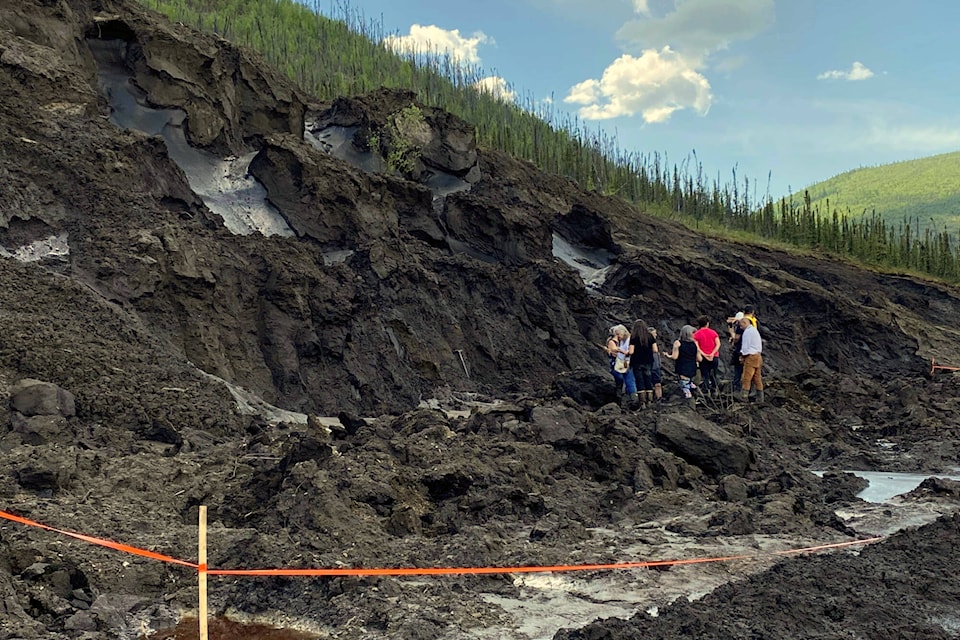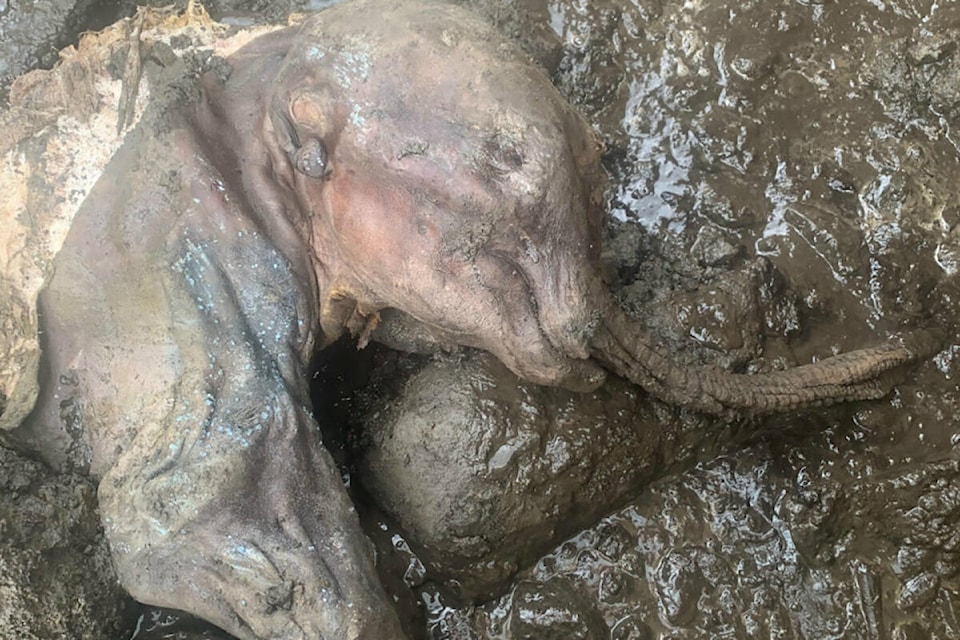The incredibly well-preserved remains of a baby woolly mammoth discovered in June 2022 near Dawson City, on the traditional territory of the Trʼondëk Hwëchʼin First Nation, will return to and remain in the area in which it died more than 30,000 years ago.
This is according to a statement by Debbie Nagano, the director of heritage with Tr’ondëk Hwëch’in, at a community info session held at Älät Nëhëjël Community Hall on the evening of Dec. 5.
The meeting, which featured presentations from paleontologists, a conservator and Nagano, among others, provided attendees with a fascinating update on the status of the deceased baby mammoth, named Nun cho ga by Trʼondëk Hwëchʼin elders. The prehistoric animal’s moniker means “big animal baby” in the Hän language.
Valerie Monahan, a conservator with the Yukon government, told attendees that the plan is for Nun cho ga’s remains to be sent to the Canadian Conservation Institute in Ottawa for preservation. An application has been filed with the institute and is pending approval.
“An application has now been put into [the Canadian Conservation Institute]. They’re a national organization. They have not approved the application. However, we feel strongly that Nun cho ga is an excellent candidate,” Monahan said.
Other remains found in the Yukon have also undergone preservation at the Ottawa institute, including the remains of a gray wolf pup, dubbed Zhùr, which was unearthed near Dawson City in 2016. Prehistoric caribou and horse specimens were also preserved at the institute.
According to Monahan, the preservation process involves cleaning the carcass before freeze-drying it to remove moisture while keeping it cold.
“The freeze dryer is basically a combination of a freezer and a vacuum pump. So, what it does is it pulls moisture out of the animal, and then that moisture is removed from the freezer in a continual cycle so that while the animal stays frozen, it dries. It’s a very slow process,” Monahan said, adding that, for large animals, the procedure could take months.
After the remains are finished being freeze-dried, they are further cleaned, and a custom support is made to display the specimen.
As mentioned earlier, if Nun cho ga does jet off to Ottawa for preservation, the baby mammoth will ultimately return to the Trʼondëk Hwëchʼin’s traditional territory.
“A lot of people, they want to know what we’re going to do with her when she does return to our traditional territory. And that hasn’t been really firmed up quite yet. But she will stay within the traditional territory of Trʼondëk Hwëchʼin,” Nagano said.
In response to a question about how Nun cho ga could be displayed, Nagano said that the baby mammoth would not be displayed behind a glass case like other specimens and wouldn’t be a tourist attraction.
“We find it very disrespectful. You’ve got to take into consideration that […] we have a connection to her, and it’s almost like a family member. So, you wouldn’t do that to a family member,” Nagano said. “So, we’re gonna have to try to figure out how to do it in a respectful way.”

In addition to discussing Nun cho ga’s future, the community meeting also touched on the baby mammoth’s past and present. The circumstances of the deceased animal’s discovery at a gold mine 60 kilometres southeast of Dawson City were recounted, including the arrival of an “incredible deluge” shortly after it was unearthed — an event that has become part of “Nun cho ga lore.”
Paleontologists Grant Zazula and Elizabeth Hall shared the history of other preserved Pleistocene animal discoveries in the Yukon and other jurisdictions and some research findings related to Nun cho ga.
Hall noted that nine baby mammoths have been found globally, seven in Siberia and two in North America. Of the two discovered on this continent, Nun cho ga is the best-preserved and most complete specimen.
“So out of the nine baby mammoths that have been found, only four of them still have the trunk attached to them. So, Nun cho ga has her trunk still attached,” Hall said.
Details about the landscape the young mammoth inhabited and information about her death in a landslide were also shared.
“There are some places in the world that sort of resemble what the Klondike plateau would have looked like during her time. [It was] very much a treeless environment, lots of shrubs and grasses and forbs around. And again, the Bering land bridge is just starting to form at 36,000 [years ago]. So yeah, you could [just barely] walk westward right across into Asia at this time,” Jeff Bond, the former manager of surficial geology with the Yukon Geological Survey, said.
Nun cho ga is regularly referred to as a female, although it was noted during the presentation that the animal’s sex is presently unknown.
Zazula also used his time at the podium to praise the emerging relationship between the Yukon government and Trʼondëk Hwëchʼin First Nation, “which combines traditional culture with scientific value.”
Contact Matthew Bossons at matthew.bossons@yukon-news.com
